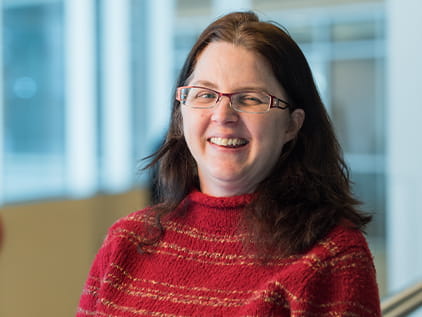Brain Aneurysm
About 1-2% of the U.S. population likely has a brain aneurysm. However, only about 30,000 of these aneurysms are likely to rupture in a given year.
Our advanced neurology and neurosurgery team provides leading brain aneurysm treatment to people in the Kansas City metro region and beyond. We offer comprehensive and interdisciplinary treatment strategies for people who have been diagnosed with or suffered the effects of vascular disorders, including aneurysm and stroke.
What is a brain aneurysm?
A brain aneurysm is a weak area in the wall of an artery that delivers blood to the brain. Though often harmless, these weak areas can bulge and burst, resulting in dangerous or even fatal ruptures that release blood into the skull.
We offer a variety of appointment types. Learn more or call 913-588-1227 to schedule now.
Brain aneurysm symptoms and risks
Most brain aneurysms have no symptoms. Unruptured brain aneurysms may occasionally cause headaches, visual disturbances or speech issues. Ruptured brain aneurysms are an emergency and may be indicated by:
- Loss of consciousness
- Nausea and vomiting
- Seizures
- Sudden, severe headache
Risk factors include family history of aneurysm, previous occurrence of aneurysm, high blood pressure and tobacco use. Gender and race are also risk factors, with women more likely than men to experience an aneurysm and African Americans are more likely than Caucasians.
Brain aneurysm diagnosis and screening
With most aneurysms exhibiting no symptoms, unruptured aneurysms are sometimes found during imaging tests like an MRI or CT scan.
Screening for unruptured brain aneurysms is not usually recommended. However, there are certain situations in which it may be beneficial to have an imaging test for an unruptured brain aneurysm, such as:
- You have 2 first-degree relatives with a brain aneurysm
- You have a congenital disorder that increases your risk of having a brain aneurysm

Expert team provides advanced care
A carotid artery aneurysm threatened Rebecca’s life. A multidisciplinary team took action. Advanced neurosciences and vascular care put a stop to the risk and returned her safely to her beloved books and garden.
Brain aneurysm treatment
At The University of Kansas Health System, you'll receive access to the best brain aneurysm treatment options, including leading research and clinical trials. Your doctor may consider a number of brain aneurysm treatment options:
Debbie Green: I feel fantastic. I feel like I've been healed.
Narrator: That's today, but just 24 hours ago, Debbie Green had an aneurysm in her brain. Previous attempts to treat it had failed.
Debbie: I've already been through the coiling and it didn't work. Then I was scheduled for the PulseRider and it didn't fit, so I'm praying that this is the right fit.
Narrator: Here at The University of Kansas Hospital, specialists believe an FDA-approved treatment called the WEB is considered the most advanced and safest solutions for aneurysms.
Dr. Koji Ebersole: This is the aneurysm right here. It's about a medium-sized aneurysm, so this is greatly magnified. In real life this thing is about the size of an eraser head.
Debbie: The aneurysm is in a place that if it ruptures, then I wouldn't be able to speak and I wouldn't be able to use my right side, so that worries me a lot because God knows I need to speak.
Dr. Alan Reeves: The WEB device represents a very unique opportunity for us to treat aneurysms basically in a single shot.
Dr. Koji Ebersole: It's kind of like a woven basket, so that if you get it sized just right it will fit inside the aneurysm with a single device. That's different than coils. A coil to treat a similar aneurysm oftentimes requires more than the coils itself; for example, a stent, which requires you to be on blood thinners. This is a single device that goes inside of an aneurysm, and when you detach it, it remains inside the aneurysm, and in successful cases leads to a closure of the aneurysm, so a minimally invasive cure for brain aneurysms.
Debbie: Hello.
Dr. Koji Ebersole: How are you, good?
Debbie: Good.
Narrator: Debbie is just happy to have her peace of mind back.
Debbie: I was willing to go through it, and hopefully it'll do what it's supposed to do, and it did. I had it done a little over 24 hours ago and I'm going home.

Get started as a new patient
Before your first appointment, sign up for MyChart. MyChart allows you to fill out new patient paperwork, get directions to your appointment and communicate with your care team.
Why choose us for brain aneurysm treatment
At The University of Kansas Health System, our specialists have consistently been among some of the first to incorporate new advancements into their daily practices, such as the Pipeline™ Flex embolization device and Surpass® flow diverter, to support high-risk brain aneurysm treatment.
Our brain aneurysm experts provide complete aneurysm care from prevention to treatment and beyond. One of the ways we demonstrate our belief in comprehensive care for patients and families is through our brain aneurysm support group. We bring together physicians, psychologists, nurses and other support personnel to address your needs after aneurysm.

Leading research and clinical trials
As part of one of the nation's premier academic medical centers, our care providers are committed to research and scientific discovery through the University of Kansas Medical Center. We can often include our patients in potentially lifesaving clinical trials and treatment options not available anywhere else.
We have created a unique opportunity to take a multidisciplinary approach with patients with any kind of brain vascular problem. We have radiologists, neurologists and neurosurgeons who specialize. We’re the only center in the region with all 3 specialties. We consult and collaborate to verify the best treatment for each patient. – Alan Reeves, MD
Interventional neuroradiologist

Find a doctor
Doctors at The University of Kansas Health System are care providers and researchers at the forefront of new medical discoveries. From primary care to complex conditions, we offer hundreds of specialists.




